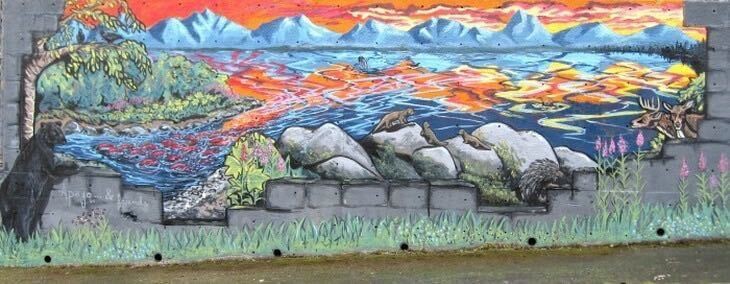
Q: It seems like your heritage, culture, and subsistence life in rural Alaska are your primary inspirations for your work; can you share more about that and what specifically inspires you?
Apayuq: There is a wellness in the mindless actions of work. A sense of peace, meditation, and general sense of “being”. When we can remove the verbalized and literary thoughts of living, there is wonderment and wordless purpose in life. Often we ask ourselves, what is the meaning of life, or, what is the meaning of my life? Moving through my art practice over the years, the thought and inability to fully articulate why I do this, today it feels like the inspiration is in the wordlessness and instinctual act of what this way of life provides. It’s a space and other world of being, that perhaps is in the realm of spiritually living that inspires my art. It lives more in the unthought, than thought out.
Q: Your passion for art came from many parts of your life and experiences; was there ever a time where you doubted the path you are on now? How did you overcome it?
Apayuq: Adolescence was very self moderated. They say “latch key” kids. I was offered a lot of freedom in my choices, so when it came to career paths, my guardians didn’t offer any direct advice. It helped to discipline my own questioning on how I could get by in a way that felt fulfilling and satisfied the need for belonging that had been subconsciously guiding my actions. I wanted a life that flowed and felt natural, that allowed for wilderness time and wasn’t sacrificing my ethical values. With this simplified mindset, I followed my intuition to allow my natural talents to pull me into each opportunity with an open mind that emphasized, each experience would be bigger and better and it would always work out. Trust the process and never give up.
Q: Do you see your work as having traditional values or non-traditional?
Apayuq: These aren’t thoughts that are a part of my work. The goal is to be true to who I am and the knowledge that has been planted consciously and subconsciously. And being part of a living culture, history in the present, “traditional” is a term that modern culture often uses to restrain and suppress cultures -holding back the effort to evolve and maximize ancestral knowledge paired with modern and present. Sometime in the future, I’m sure my subject matter would be considered traditional, but today, my style hasn’t been used long enough to be considered traditional art.
Q: Do you photograph pictures when you are out fishing and then paint from them or do you just paint from memory?
Apayuq: Just this week, I read an article about people who are not able to visualize images in their mind’s eye! Which made me realize what a gift I have. I am able to imagine scenes and relay it to physical imagery. Once my scene is laid out, I use general photos for details, such as the exact look of a fin. I know a salmon has a fin with lines, but my mind visuals aren’t photographic.
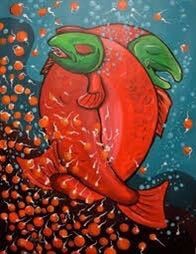
Q: Who is your favorite artist or artists? And can you explain why they are your favorite?
Apayuq: I wasn’t habituated to finding favorite figures to obsess over. I also didn’t grow up in an economic situation that allowed popular culture to be a significant part of life. I think in a way we are taught to observe people who work hard and their actions and the way they live are what dictate their community value and esteem. Creating work is about having honesty, follow-through and integrity. With that in mind, I’ve always valued the quality my grandma, mom and aunts put into their work. They were incredibly honest about the flaws and weren’t afraid to redo “bad” work. They were humble in completion and the self satisfaction of creating something that could be passed on to another with confidence of longevity. I also loved my cousin’s grandpa T’gen (Willie Wassillie) and his wife Margaret Wassillie. They were avid outdoors people and subsistence harvesters who had incredible carvings and skin sewing. To see their life conduct and completion of craft, amazed me. And still does. It’s like the people whose life in a holistic way are an artwork in themselves, those people impact me the most.
Q: What is your art background? When did you know you wanted to be an artist?
Apayuq: I think the way I was raised is we are what our skills are. So it wasn’t a matter of wanting to be an artist, it was that I was always an artist. But capitalism as the overall social construct of American life, has made it almost mandatory to identify with what makes an individual profitable. But in college, is when I realized I could satisfy the capitalistic standard of worth through my ability to make profits on what I am.
Q: How was the transition away from Alaska when you went to college?
Apayuq: I was in absolute culture shock. The objectification and cold nature of strangers in larger cities was hard to adjust to. Not saying hi to everyone and the sense of such extreme individualism was frightening. It offered a time to learn on a sharp learning curve about the uniqueness of Bristol Bay and the culture I was raised in. There was an epiphany that my home seemed like another country within it’s own country and speaks to the assimilation problem the American dream forces. Though I was told I was an American citizen, I felt so far from what that stood for, and my way of life was worlds away from what I was experiencing in my new education system.
Q: Do you ever use your art to send a political message, if so, what kind of message do you wish to send with your work?
Apayuq: Sometimes. In general, my work reflects what I know to be true or feel as myself. But in the larger sense, it’s shared to normalize the better parts of indigenous identity. It reflects our better nature that gets suffocated by western stereotypes of worthless savage people who disregard health with pop and candy, smoking and excessive drinking. My work refuses to disregard the realities of what has caused some to suffer so traumatically that they act it out in their lives, and holds true to the truth of the good in us. Hopefully setting the example that we can learn and move on through understanding our history, human behavior, compassion and following healthy examples of our people to flourish in our environment. Sometimes it just takes a smile to change the behaviors we act out.
Q: What kind of social challenges have you faced before as an indigious person and are these challenges ever seen in the art you’ve created?
Apayuq: Blood quantum has been the most ironic part of my life. As a child, we don’t realize our physical appearance for many years. I grew up with a fluent Yup’ik family and my sense of self was that I looked and sounded like the people around me. It wasn’t until 5 that my appearance and the comments of peers on my appearance made it apparent that I was different. It was an internal conflict, because I had been raised as a Yup’ik but was being told I was something I didn’t feel that I was. In my paintings, I catch myself painting Yup’ik looking people and need to make a conscious effort to also depict indigenous people who look more like me. My subconscious says I look pure Yup’ik, and the us government blood quantum reminds me that my heart doesn’t have a say in my pureness.
Q: Many of your works focus on natural cycles. Have environmental changes impacted your art or inspirations?
Apayuq: The constant threat of development, particularly wasteful and what seems like unnecessary development, in wild places that provide food and water, is always on my mind. We watch how monetary economic systems overrule all other economies. My work definitely depicts a different type of value system that focuses more on non-monetary life enrichment.
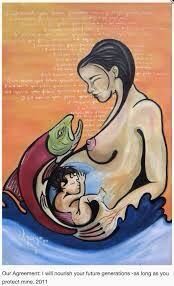
Q: Bristol Bay looks to be somewhere you’re very attached to, what are some of your favorite works you’ve made inspired by Bristol Bay and what about it inspired you to make these favorite works?
Apayuq: The murals I’ve created for the Bethel community are in my top feel good work. The size of the murals (over 50′) are the closest to and immersed experience I’ve been able to create. It’s like sitting in a real scene and the feeling can really take you in, just like being out in the tundra. I also like creating pieces, such as “Welcome Home” or Aneeq-Spirit-Breath, that incorporate human imagery within the land, showcasing our interconnectedness.
Q: Do you think you started to create art to bring awareness to things that are important to you and your community? Or do you think you were an artist and then grew through that process and it made you want to bring awareness to global issues that are affecting your home and culture?
Apayuq: I have always created art, but with age comes new responsibility. The social responsibility we all have, gave a purpose to creating the artwork. As long as that purpose and my skill allows, I’ll likely be inspired to create art with a message.
Q: In addition to your smaller scale paintings, you’ve worked on quite a few murals; Do you have a preference for working on smaller or larger scale works?
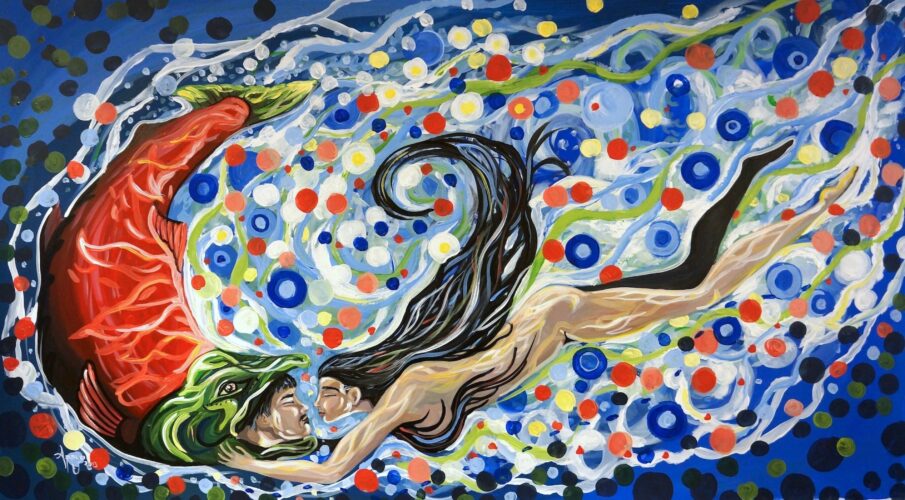
Apayuq: I love working in large scale mural size. The full body effort and the forgiveness of muraling is very fulfilling on many dimensions.
Q: I see that you made grass baskets in the past. Did you learn from an elder or did you take a class?
Apayuq: I have never completed a grass basket and have only started one. I took a class at UAF with my aunt Loulare Moore, who is an absolutely gifted basket baker. Right before Covid, I had planned to do a grant funded class with her, but it fell apart in the unknown. Instead, I learned how to pick grass for baskets, and was directed by my mom and grandma in the proper way to choose grass.

Q: Do you have a favorite medium you enjoy working with? What other mediums do you want to explore someday? Do you have any interest in carving?
Apayuq: An important trait I’ve learned to cherish in our Indigenous cultures, is the emphasis to have the capability to do all things. I wasn’t raised to create one type of art, nor would I expect myself to only do one thing. I grew up beading, skin sewing, carving, wood working, creating clay pottery, sewing, drawing etc. Along with this, I don’t expect my art to define my life. It is also important that I live in a way that demonstrates the ability to constantly change and learn trade skills that are necessary in my life. What we are told to contract out in urban society, I expect that I am able to do on my own. Things like changing oil on my generator, basic maintenance, changing tires, building shelves, harvesting firewood, operating my skiff to harvest food. All of this is necessary to make a living, and the art is just a small part that helps tie it all together.
Q: Was there ever an art piece you created that you loved but was misunderstood or disliked by everyone else? Was there ever a hidden meaning in your art piece that you hoped to come across with your viewers?
Apayuq: absolutely love “The Rape of Mother Earth” and nobody else likes it. Its a raw and honest depiction of rape, and how we disregard worth of feminitity.
Q: Has motherhood changed the way you express yourself artistically?
Apayuq: Motherhood has grounded a sense of care for others. I think a nurturing element was strengthened after having children.
Q: What do you hope people take away from your art?
Apayuq: I guess a sense of humanity. Relationship to each other and undoing the objectification of native people.
Q: Where do you hope to be with your art in the next ten years?
Apayuq: I hope to be in a space that allows more freedom from the pressure to make money off of the art. It would be nice to create out of my own free will.
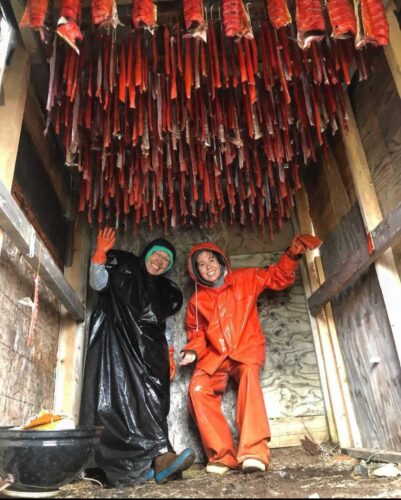
Apayuq currently resides in Aleknagik, Alaska with her two children. She has no plans for 2022 on any upcoming exhibits. We look forward to see what she creates next.